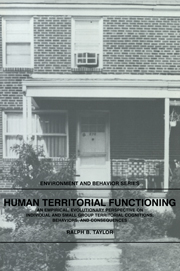 Human Territorial Functioning
Human Territorial Functioning In recent decades the relationship between human behavior and the physical environment has attracted researchers from the social sciences – psychology, sociology, geography, and anthropology – and from the environmental-design disciplines – architecture, urban and regional planning, and interior design. What is in many respects a new and exciting field of study has developed rapidly. Its multidisciplinary character has led to stimulation and cross–fertilization, on the one hand, and to confusion and difficulty in communication, on the other. Those involved have diverse intellectual styles and goals. Some are concerned with basic and theoretical issues; some, with applied real–world problems of environmental design.
This series offers a common meeting ground. It consists of short books on different topics of interest to all those who analyze environmentbehavior links. We hope that the series will provide a useful introduction to the field for students, researchers, and practitioners alike, and will facilitate its evolutionary growth as well.
To save this book to your Kindle, first ensure no-reply@cambridge.org is added to your Approved Personal Document E-mail List under your Personal Document Settings on the Manage Your Content and Devices page of your Amazon account. Then enter the ‘name’ part of your Kindle email address below. Find out more about saving to your Kindle.
Note you can select to save to either the @free.kindle.com or @kindle.com variations. ‘@free.kindle.com’ emails are free but can only be saved to your device when it is connected to wi-fi. ‘@kindle.com’ emails can be delivered even when you are not connected to wi-fi, but note that service fees apply.
Find out more about the Kindle Personal Document Service.
To save content items to your account, please confirm that you agree to abide by our usage policies. If this is the first time you use this feature, you will be asked to authorise Cambridge Core to connect with your account. Find out more about saving content to Dropbox.
To save content items to your account, please confirm that you agree to abide by our usage policies. If this is the first time you use this feature, you will be asked to authorise Cambridge Core to connect with your account. Find out more about saving content to Google Drive.